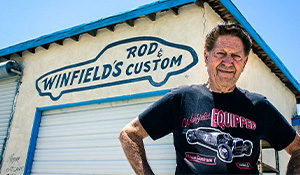TECH - Alpine Alpenglow concept
Photos: Alpine
Brought to you by Castrol EDGE
According to Alpine, the ‘Alpenglow’ concept they unveiled at this year’s Paris Motor Show is what motorsport needs to look like tomorrow.
The sporting sub-brand of Renault has declared its commitment to “entrenching sustainable development in the motorsport landscape” and the Alpenglow is their initial representation of that.

Key to the Alpenglow concept’s “sustainable” ethos is hydrogen power, which produces only steam from combustion and is already in use in fuel cell form in some electric-powered vehicles.
The hydrogen that will theoretically power the Alpenglow and other future Alpine road and race cars is apparently even “greener,” as it will be refined in a way that is carbon neutral.
Importantly for fans of sports cars with conventional internal combustion engines, this greener power won’t be used by Alpine as a fuel cell for an electric motor. Rather, it will fuel an internal combustion engine that will produce the types of induction and exhaust sounds that fans know and love.
While providing no details of the engine, nor any samples of its sound, Alpine says the evocative engine note in the concept will also apply to its future production equivalent.

Step One
Alpine describe the Alpenglow as the first step on a path to sustainable solutions and clean mobility for the brand, combining EVs with fuel cell vehicles and hybrids using the aforementioned carbon-neutral hydrogen refining.
By combining new and developing hydrogen technologies with technical expertise honed in the field of motor sport, Alpine believe they can provide future vehicles “with the kind of performance only racing cars can reach”.
Hydrogen virtually eliminates emissions, but unlike electric, it retains the type of induction and exhaust sounds that are so entrenched in top-level motorsport like the FIM World Endurance Championship and Formula 1.
Alpine will draw on the experience of parent company Renault to develop these technologies, as well as French-based hydrogen mobility company Hyvia. The Alpine F1 team have already entered a partnership with Hyvia to invest in hydrogen engine tech and a transition to sustainable mobility.

Born to Race
Clearly, the Alpenglow concept is a competition vehicle, with some predicting that it will form the basis for Alpine’s next challenger in Le Mans-style endurance racing, specifically the LMDh class for which Peugeot unveiled their equally innovative contender earlier this year.

The cockpit places the driver front and centre, flanked by two hydrogen tanks shaped like waterdrops and rated at 700 bar pressure. According to Alpine, the single-seat configuration immerses the driver in the vehicle and “triggers emotions” they will never forget.
A geometric steering wheel, inspired by what’s already in use on LMP endurance racers, faces the driver, with selectors for various functions, like Regenerative Braking, Track Control and a push-to-pass style power booster, at the wheel’s base. Again, these features are inspired by endurance racing.
A prism-shaped ignition key inserts into the steering wheel, accented with snowflake motifs that pickup on the “Alpine” name, and illuminating a pyramid at the centre when the vehicle starts.

The steering wheel features transparent paddle shifters, with the pedals also transparent, adding to the sense of space and weightlessness of the interior.
This use of transparent components is reflected outside the cabin, too.

Size, Stars and Snow
Moving to the Alpenglow’s exterior, much of the styling is about maximising aerodynamic efficiency, rather than making a design statement. This “form follows function” approach was based largely around how to most effectively package the pair of essential hydrogen tanks within the concept.
That being said, the process wasn’t entirely utilitarian, with some flair seen in things like the lighting and wheels.
The concept’s exterior colour, predominantly in a brighter, deeper version of Alpine’s signature blue, is accented with traces of red and white, as well as transparent parts, like the interior.

These tones and treatments are said to be inspired by natural elements, like fire, water, steam and even snow, with red zones representing heat, while blue hints at the cold weather of the Alps and transparent parts suggest ice.
Manufacturing the concept’s body almost entirely from recycled carbon fibre adds to its “green” credentials, as well as making it extremely light. Alpine provides no numbers, but outside sources have estimated the Alpenglow to be in the 1000 to 1200kg range, which is about the same as the current Alpine A110 road car, despite the concept being significantly larger, at 5+ metres long and 2 metres wide but less than 1 metre high.

The need to optimise airflow over and around these dimensions has resulted in the concept’s “twisted” shape, with broad front and rear elements tapering toward the centre and appearing to wrap around each other.
Large air inlets in the front end and on the flanks form what Alpine call an aerodynamic tunnel, while the long and slender rear wings are inspired in part by Alpine’s A220 endurance racer from the 1960s.

An illuminated line that runs down the middle of the car is said to reinforce the central position of the driver and was inspired by the path of a comet, fading from red to various shades of blue.
This strip visually combines with the concept’s front lighting, which takes the form of a narrow, full-width horizontal strip, joined to a short vertical section to form a ‘T’. At the horizontal extremities, small triangles of light branch off, inspired by stars and creating an impression of movement.

Tail lights are incorporated with vents for the concept’s exhaust pipes and feature transparent blades with a blue tinge that’s accented by the steam produced by the hydrogen propulsion system.
Transparent sections also feature on the bonnet and wheels, which are shaped like snowflakes and incorporate triangle motifs, picking up on themes explored with the interior.
Perhaps the signature feature on the Alpenglow is its rear wing, which is also completely transparent, but remains functional and is of the actively adjustable type, according to Alpine.
Identifying Alpine script and the brand’s ‘A’ logos feature outside, while subtle French flags grace the sides of the cabin and the interior.

Future Fleet
While the Alpenglow points to the next generation endurance racer in the LMDh hypercar class to wear the Alpine name, it’s just one vehicle in a future catalogue that will include what the French brand calls its ‘Dream Garage’ of fully electric models which, initially, consists of a Renault 5-inspired hot hatch, a sporty crossover and an EV version of the current A110.
While the hydrogen-fuelled internal combustion engine in the Alpenglow is still some way off becoming mainstream, the concept’s use of recycled carbon fibre will be applied to future production cars, with some design elements from the concept to be added to the Dream Garage models, too, including the lighting and steering wheel.
"Alpenglow’s mighty and lavish design hints at what Alpine cars will be like tomorrow and our vision for motorsports moving forward,” says Alpine CEO, Laurent Rossi.













